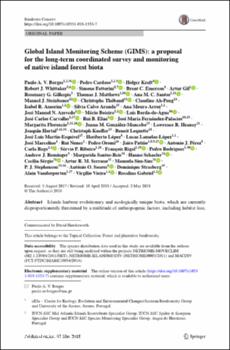Global Island Monitoring Scheme (GIMS): a proposal for the long‑term coordinated survey and monitoring of native island forest biota
Date
2018Abstract
Abstract Islands harbour evolutionary and ecologically unique biota, which are currently
disproportionately threatened by a multitude of anthropogenic factors, including habitat loss, invasive species and climate change. Native forests on oceanic islands are important refugia
for endemic species, many of which are rare and highly threatened. Long-term monitoring
schemes for those biota and ecosystems are urgently needed: (i) to provide quantitative
baselines for detecting changes within island ecosystems, (ii) to evaluate the effectiveness of
conservation and management actions, and (iii) to identify general ecological patterns and processes using multiple island systems as repeated ‘natural experiments’. In this contribution,
we call for a Global Island Monitoring Scheme (GIMS) for monitoring the remaining
native island forests, using bryophytes, vascular plants, selected groups of arthropods and
vertebrates as model taxa. As a basis for the GIMS, we also present new, optimized monitoring
protocols for bryophytes and arthropods that were developed based on former standardized
inventory protocols. Effective inventorying and monitoring of native island forests will
require: (i) permanent plots covering diverse ecological gradients (e.g. elevation, age of terrain,
anthropogenic disturbance); (ii) a multiple-taxa approach that is based on standardized
and replicable protocols; (iii) a common set of indicator taxa and community properties that
are indicative of native island forests’ welfare, building on, and harmonized with existing
sampling and monitoring efforts; (iv) capacity building and training of local researchers, collaboration
and continuous dialogue with local stakeholders; and (v) long-term commitment
by funding agencies to maintain a global network of native island forest monitoring plots.






